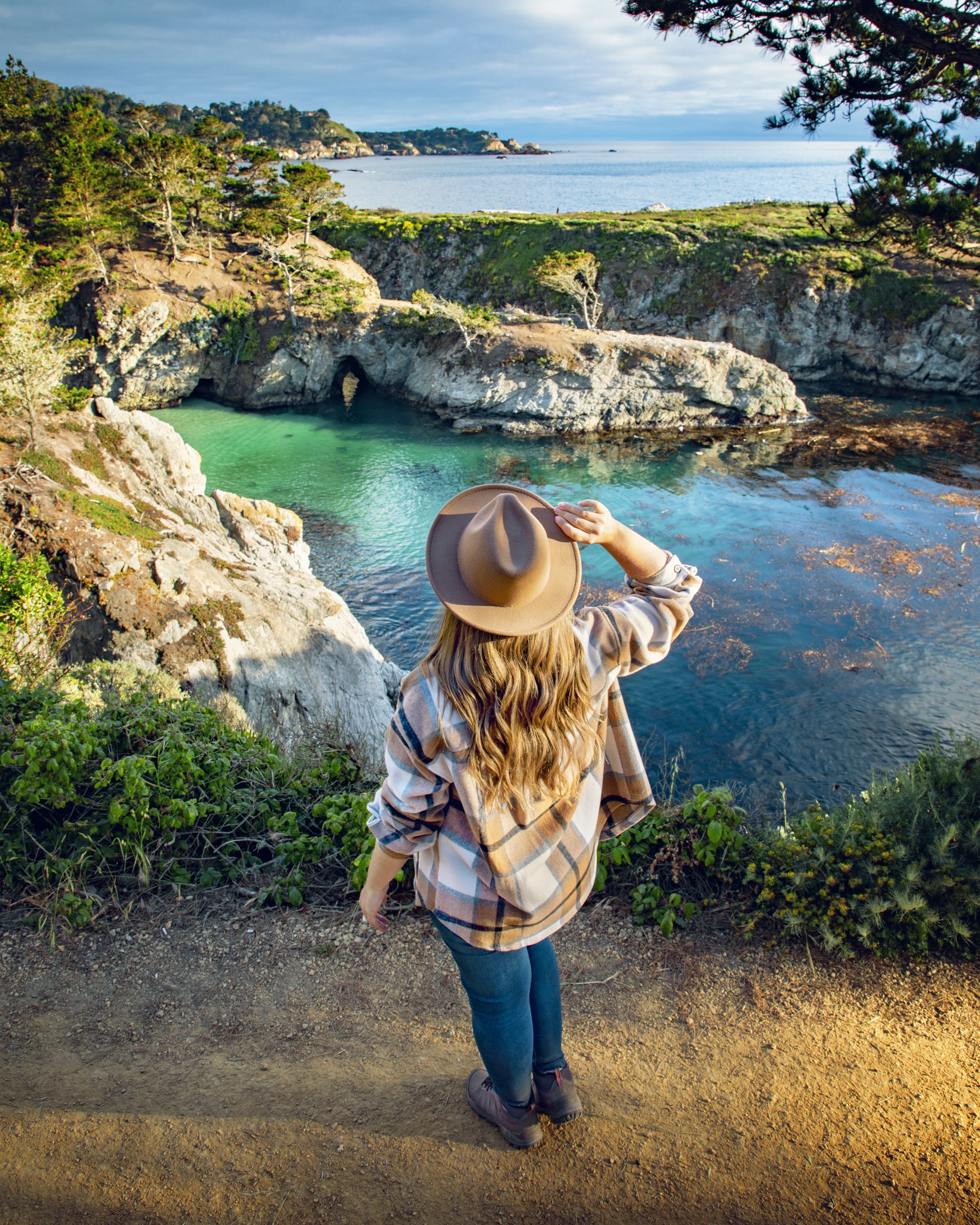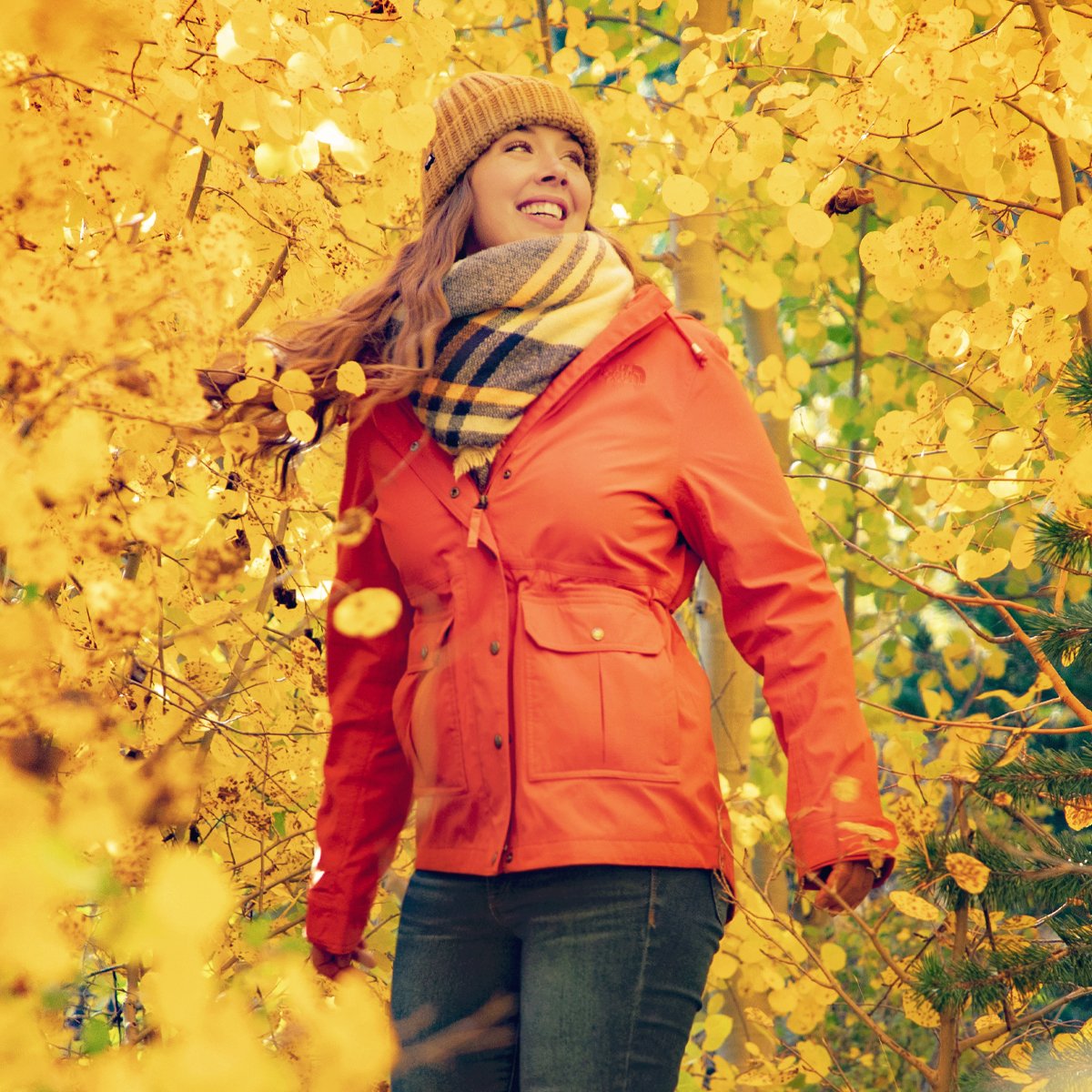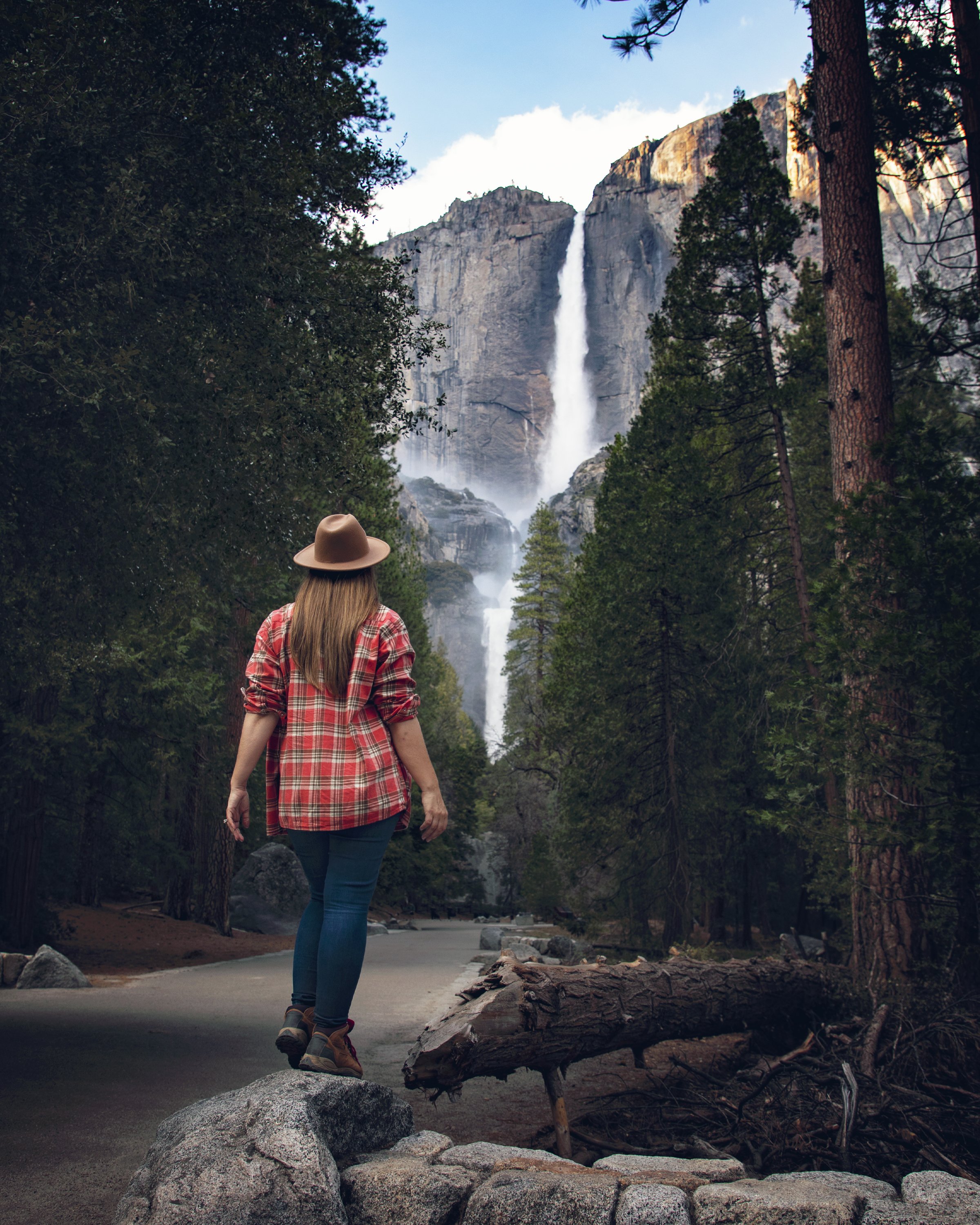Ultimate Guide to CA State Parks in Big Sur
Big Sur, a rugged stretch of California’s central coast between Carmel and San Simeon, offers some of the most breathtaking scenery in the world. Home to towering redwoods, dramatic cliffs, and abundant wildlife, this region is a paradise for nature enthusiasts and adventurers alike. This Ultimate Guide to California State Parks in Big Sur will help you navigate the best spots, trails, and experiences along this iconic coastline. Join me below as we head down Highway 1 from north to south, visiting all 8 state parks in Big Sur, discovering the unique treasures each one has to offer you on your next central coast road trip.
China Cove at Point Lobos State Natural Reserve
1. Point Lobos State Natural Reserve
Point Lobos, often referred to as the "crown jewel" of the California State Park system, boasts spectacular coastal vistas, rich marine life, and diverse flora. The turquoise waters and rugged cliffs create picture-perfect views at every turn. Located at the very north end of the Big Sur coastline in the charming town of Carmel-by-the-Sea, Point Lobos boasts some of the most diverse and rich marine habitats in the state. In fact, landscape artist Francis McComas referred to this area as the “greatest meeting of land and water in the world.” The reserve covers a small peninsula jutting out at the southern end of Carmel Bay. From Whaler’s Cove and the North Shore Trail, you can see Pebble Beach and the town of Monterey to the North. To the south of Point Lobos, you’ll of course find the one of the most incredible stretches of coastline anywhere, Big Sur.
Brandt’s cormorant birds nesting along Pelican Point & Bird Island during breeding season
Cypress Grove Trail at Point Lobos State Natural Reserve
Wildlife
Visitors can spot sea lions, harbor seals, and sea otters along the shore. The reserve is also a birdwatcher's haven with species like cormorants, pelicans, and black oystercatchers.
Best Times to Visit
Spring and fall are ideal, offering mild weather and fewer crowds. Early mornings provide the best wildlife viewing opportunities. Although a bit more crowded, sunsets are magical here as the low lighting casts a warm glow across the natural features.
Popular Hiking Trails
Cypress Grove Trail: A short 1-mile scenic loop through one of the two naturally growing stands of Monterey cypress trees.
Bird Island Trail: An easy 1-mile lollipop loop offering stunning views of China Cove (the most photographed spot in the park) and Bird Island, where hundreds of unique seabirds nest.
Tips
Make sure to bring binoculars for wildlife viewing and arrive early as the parking lot fills up quickly. Currently the reserve hours are from 8am-7pm and the Whalers Cabin Museum (a historic cabin built in the 1850s) is open from 9am-5pm, but make sure to check the official State Parks page for the most up-to-date information.
For more information on this incredible unit in the California state park system, check out my First-Timer’s Guide to Point Lobos State Natural Reserve.
Garrapata State Park in Big Sur
My Photography Gear
I get so many questions about what equipment we use on our adventures, so below I’ve listed out our most used photo gear 😊
If you make a purchase through these links, we may earn a small commission at no extra cost to you. This helps offset the cost of running this site so we can continue to provide you with free content.
Garrapata State Park in Big Sur
2. Garrapata State Park
Garrapata State Park features dramatic coastal cliffs, hidden coves, and scenic vistas of the Pacific Ocean. The park is also known for its beautiful wildflower displays in spring, including the magical Calla Lily Valley. Set at the base of the Santa Lucia Mountain range along the north end of Big Sur and covering nearly 3,000 acres, Garrapata State Park reaches from the rugged sea caves and rocky shoreline to the deep inland canyons and steep mountainous terrain.
Rugged coastline along Garrapata Bluff Trail in Big Sur
Calla Lily Valley in Big Sur’s Garrapata State Park
Wildlife
Over 60 species of mammals and 110 species of birds make their home inside the park. Gray whales pass by during their migration, and sea lions, harbor seals and sea otters frequent these waters as well.
Best Times to Visit
Spring and early summer are great for wildflower viewing. Winter months offer excellent opportunities to see migrating whales. High tides are an exciting time to visit, as visitors can safely view massive waves crash up against the iconic rocky shoreline from the bluff-top trails.
Popular Hiking Trails
Garrapata Bluff Trail: A short 1-mile trail with breathtaking ocean views and access to secluded beaches.
Soberanes Canyon Trail: A moderate 3-mile hike through redwoods and along a creek, offering a mix of coastal and inland scenery.
Tips
Wear sturdy shoes for hiking as some trails can be steep and rocky. The park is marked by 19 small numbered turn outs along Highway 1, and you could miss the park entirely if you didn’t know to look for it. Garrapata is one of the foggiest spots in Big Sur. It’s known for cool mornings, strong winds, and hot Summer afternoons, so be prepared with layered clothing when you visit.
For more information on this California state park in Big Sur, check my full Garrapata State Park blog post.
Point Sur State Historic Park in Big Sur
3. Point Sur State Historic Park
Point Sur State Historic Park is located on the rugged Big Sur coastline, approximately 19 miles south of Carmel along Highway 1. This park is renowned for the historic Point Sur Lighthouse, perched atop a dramatic volcanic rock outcropping overlooking the Pacific Ocean. Established in 1889, the lighthouse has guided ships along this treacherous stretch of coast for over a century. Visitors can explore the lighthouse and the surrounding buildings through guided tours, which provide fascinating insights into the lives of the lighthouse keepers and the maritime history of the area. The combination of historical intrigue and stunning coastal views makes Point Sur State Historic Park a must-visit destination in Big Sur.
Point Sur Lighthouse in Big Sur
Point Sur State Historic Park seen from Valley View Trail in nearby Pfeiffer Big Sur State Park
Wildlife
In the adjacent waters are the Point Sur State Marine Reserve (SMR) and Point Sur State Marine Conservation Area (SMCA), as well as the Monterey Bay National Marine Sanctuary. These protected habitats are abundant with all kinds of sea birds and marine mammals like seals and sea lions, which are often visible from the lighthouse.
Best Times to Visit
Year-round, but tours are weather dependent and are only offered on specific days and times. Three hour guided walking tours of the Point Sur Lightstation can be enjoyed on Saturdays & Sundays at 10am and Wednesday at 1pm. These tours are the only way to access the lighthouse, and I’d recommend checking the schedule and making reservations in advance here.
Popular Hiking Trails
There are no official hiking trails within the park, but the guided tour includes a walk up to the lighthouse.
Tips
Bring a jacket as it can be windy and chilly, as well as some binoculars for wildlife viewing. You can also book 2-hour guided tours on Saturdays at 10:30am of the Historic Point Sur Naval Facility, which was once a top secret Cold War military location.
Low tide at Molera Beach in Big Sur
4. Andrew Molera State Park
Andrew Molera State Park is located approximately 20 miles south of Carmel on Highway 1 in Big Sur. This park is unique in its relatively undeveloped landscape, offering visitors a more rustic and natural experience compared to other parks in the area. Named after Andrew Molera, an early pioneer in the Big Sur region, the park was established following a land donation by the Molera family to preserve the natural beauty of the area. Unlike its more developed neighbors, Andrew Molera State Park features expansive meadows, a scenic beach, and diverse ecosystems ranging from redwood groves to coastal bluffs. With fewer facilities and a focus on preserving the natural environment, the park offers a more secluded and tranquil escape, making it a perfect spot for those looking to experience the raw beauty of Big Sur.
Molera Beach in Big Sur’s Andrew Molera State Park
Crossing the Big Sur River along the Creamery Meadow Trail in Winter
Wildlife
Birdwatchers can enjoy a diverse range of species. River otters, bobcats, and deer are also commonly spotted. In December and January visitors can also find western monarch butterflies in the eucalyptus trees surrounding the Cooper Cabin, the oldest surviving ranch structure and building on the Big Sur Coast.
Best Times to Visit
Late Spring to early Fall will provide milder weather without muddy trails, however Summer is far more crowded than other times of the year.
Popular Hiking Trails
Creamery Meadow Trail: A 2-mile out and back hike leads visitors across the Big Sur River to a beautiful sandy beach with fewer crowds. Just note that a seasonal footbridge over the river is only up from mid-June through October...so if you visit during the Winter months you’ll have to wade through the knee-deep waters at the beginning of the trail.
Ridge Trail Loop: A more challenging hike with rewarding views of the Big Sur River Valley and coastline along this 3-mile trail.
Tips
Make sure to check trail conditions ahead of time on the official park website, as some can be closed due to weather. The Creamery Meadow Trail not only provides access to the beach, but also to several other trails in the park, so keep that in mind as you prepare for your adventure, especially if it requires wading through the Big Sur River during the Winter months when the seasonal footbridge is removed. Also keep an eye on the tide charts if you’re planning a beach hike...Molera Beach can all but disappear during high tides.
Fore more information on this incredible state park, check out my Andrew Molera State Park section.
Coastal redwood trees in Pfeifer Big Sur State Park
5. Pfeiffer Big Sur State Park
Pfeiffer Big Sur State Park can be found right off the picturesque Highway 1 near the small community of Big Sur village, approximately 25 miles south of Carmel. The park was created to preserve the area's stunning redwood forests and rich ecosystems, and it’s named after John Pfeiffer, who once owned the land and sold 700 acres of it to the state of California in the 1930s. Known as "Little Yosemite," the park now covers over 1,000 acres of unspoiled wilderness featuring ancient redwoods, meandering rivers, and rugged cliffs.
Pfeiffer Falls reached by the Valley View Trail in Big Sur
Big Sur River in Pfeiffer Big Sur State Park
Wildlife
Look out for black-tailed deer, gray foxes, bobcats, and an array of birds, including wild turkeys that are often seen along the trails. Although not quite as a common sight as little further south of here, visitors may also catch glimpses of the endangered California Condor soaring up above. Guests can check out the virtual reality experience of flying like a condor, as well as learn about other park Big Sur wildlife at the Ewoldsen Memorial Nature Center in the park.
Best Times to Visit
Spring and Fall offer the best weather and fewer visitors. Summer can be extremely crowded in this area of Big Sur, and although it’s the most quiet in the Winter, rainy weather is prevalent this time of year.
Popular Hiking Trails
Nature Trail & River Path Loop: Family-friendly 1-mile loop through a towering coastal redwood grove along the Big Sur River.
Valley View Trail: 2.5-mile round trip hike offering panoramic views of the Big Sur River Valley and Point Sur with access to Pfeiffer Falls via a short spur trail.
Tips
Camping is available here, but the campgrounds fill up quickly in peak season, so reserve early if you plan to stay overnight. I’d highly recommend a stay at the Big Sur Lodge found in the park, which provides quick and easy access to the trail systems and is a great central location for many Big Sur attractions, like the nearby Pfeiffer Beach with Keyhole Arch rock formation.
For more information on this great Highway 1 stop, check out my Pfeiffer Big Sur State Park section.
McWay Falls in Julia Pfeiffer Burns State Park
6. Julia Pfeiffer Burns State Park
Julia Pfeiffer Burns State Park is located approximately 37 miles south of Carmel along Highway 1 in the heart of Big Sur. The park is named in honor of Julia Pfeiffer Burns, a respected rancher and pioneer in the Big Sur area, whose friends donated the land to the state in her memory in the 1960s. This park is renowned for its dramatic coastal scenery and iconic landmarks. McWay Falls, an 80-foot waterfall that cascades directly onto the beach, is one of the park’s most stunning highlight. Julia Pfeiffer Burns State Park offers a variety of experiences, from hiking through lush redwood forests to exploring scenic coastal trails, making it a must-visit destination for those traveling through Big Sur.
Partington Cove in Big Sur’s Julia Pfeiffer Burns State Park
Big Sur coastline in Julia Pfeiffer Burns State Park
Wildlife
Whale watching is popular here during migration seasons. The Julia Pfeiffer Burns State Park Vista Point is a great spot to see humpbacks due to the natural underwater topography, and California condors are often seen in the skies here as well. Sea otters and seals can also often be seen in the along this section of the coast.
Best Times to Visit
Year-round, but visiting early or late in the day can help avoid the crowds, especially in non-Summer months. Sunsets are absolutely magical here, providing a golden glow across the coastal features.
Popular Hiking Trails
McWay Waterfall Trail: An easy and must-see trail on any Big Sur road trip that leads to viewpoints overlooking the famous McWay Falls spilling into a picturesque cove.
Partington Cove Trail: Takes visitors down a steep 1-mile round trip hike through a historic tunnel to a secluded rocky cove with turquoise waters that was once had a small pier used to load timber onto ships.
Tips
Parking is limited, so I recommend planning an early morning visit to ensure you snag a spot close to your destination.
For more information on this incredible California state park, check out my Julia Pfeiffer Burns State Park section.
Limekiln Trail in Big Sur’s Limekiln State Park
7. Limekiln State Park
Limekiln State Park is located just south of Lucia along Highway 1 in the southern region of Big Sur. This park is named for its historic lime kilns, which were used in the late 19th century to produce lime for construction. Visitors to Limekiln State Park can explore these well-preserved kilns, hike through enchanting redwood forests to picturesque waterfalls, camp along the Limekiln Creek, and dip their toes in the Pacific along the small beach. However, in recent years, Limekiln State Park has faced multiple closures due to wildfires, storm damage, and landslides, which have affected both the park and Highway 1.
5/27/24: Unfortunately, the park remains closed until further notice. Visitors are advised to check for updates before planning their trip to ensure access and safety.
Coastal redwood trees in Limekiln State Park
Historic lime kilns in Big Sur’s Limekiln State Park
Wildlife
The park provides a wonderful habitat for all kinds of wildlife. Mountain lions, bobcats, and foxes all call this forest home. Visitors might even see the endangered California condor and peregrine falcon in the skies above.
Best Times to Visit
Spring through Fall provides the best hiking conditions. Winter conditions can be wet and muddy. This is truly a wonderful spot to enjoy mid-day, even on hot Summer days...the forest canopy provides abundant shade on much of the hiking trails, providing much desired relief from the blazing California sun.
Popular Hiking Trails
Limekiln Trail: An easy and fascinating 1/2-mile trail to historic limekilns set amidst towering redwoods.
Falls Trail: Leads hikers along Limekiln Creek to a picturesque 100-foot waterfall in a lush forest setting.
Tips
Due to the location, this park doesn’t get quite as much traffic as the state parks to the north, making it a great option to avoid Summer crowds. Stay at the nearby Lucia Lodge for incredible clifftop views from your room.
For more information on this great stop along Highway 1, check out my full Limekiln State Park blog post.
San Carpoforo Creek Beach in Hearst San Simeon State Park
8. Hearst San Simeon State Park
Hearst San Simeon State Park bookends the southern edge of Big Sur, just off Highway 1, near the towns of San Simeon and Cambria. This expansive park, one of California's oldest state parks, was established in 1932 and boasts a rich history intertwined with the famous Hearst Castle, the opulent estate built by media magnate William Randolph Hearst. Visitors can explore a variety of natural and historical attractions within the park. The Piedras Blancas Elephant Seal Rookery is a must-see, offering a unique opportunity to observe these magnificent creatures in their natural habitat, particularly during breeding and birthing seasons. With its diverse offerings of wildlife, natural beauty, and historical significance, Hearst San Simeon State Park is a captivating destination for travelers exploring the Big Sur coastline.
Ragged Point views from San Carpoforo Creek Beach
Piedras Blancas Elephant Seal Rookery in Hearst San Simeon State Park
Wildlife
Elephant seals can be seen all along this coast, especially at the Piedras Blancas Elephant Seal Rookery. All kinds of birds species call this area home as well, including swallows during their migration period.
Best Times to Visit
Year-round, but the elephant seal rookery is particularly active in winter when the large males are fighting for mating rights and the females are giving birth.
Popular Hiking Trails
San Carpoforo Creek Beach: Provides a serene and scenic spot for beach-combing and picnicking near the Ragged Point formation, where a large lagoon forms before the creek spills into the Pacific Ocean.
Piedras Blancas Elephant Seal Rookery: A series of boardwalks provides elevated and up-close viewing areas of thousands of elephant seals.
Tips
Leave yourself plenty of time to explore this section of coastline, multiple days if possible. Moonstone Beach in Cambria, Hearst Castle, and the Piedras Blancas Lighthouse are all great activities. Watch out for poison oak when hiking here...trails are often flanked on both sides by it in this area.
Garrapata State Park In Big Sur
Know Before You Go
• Before your road trip, please learn about The Big Sur Pledge and how we can all protect and respect Big Sur’s natural resources on your visit.
• Please follow all Leave No Trace Principles and recreate responsibly here to keep theses treasures of nature wild and wonderful for generations to come. All park features are protected by law and may not be disturbed.
• Stay on trails to protect the local plants and animals, as well as to safely avoid poison oak, which grows abundantly throughout Big Sur.
• Big Sur has very limited cell service. Do not expect to have reception inside many of these state parks, so make sure to come prepared with knowledgeable navigation for your adventures.
• It’s important to check road conditions before you travel to Big Sur. Landslides are frequently a part of life along the Big Sur coast, and Highway 1 can be closed at times as a result...so double check road closures and conditions before your trip. As of the publishing of this article, Highway 1 is closed in both directions from Limekiln State Park to Lucia, which means most of the spots mentioned in this post can only be reached via Carmel from the north.
Autonomous Tent at Treebones Resort in Big Sur
Big Sur Lodge in Pfeiffer Big Sur State Park
Top 10 Big Sur Hotels & Resorts
Treebones Resort: An eco-friendly resort known for its unique yurts and autonomous tents, offering an off-the-grid experience with breathtaking coastal views.
Post Ranch Inn: A luxury resort perched on the cliffs of Big Sur, offering stunning ocean views and a serene, adults-only atmosphere.
Ventana Big Sur: An upscale resort set amidst the redwoods, featuring elegant rooms, glamping options, an infinity pool, and Japanese hot baths.
Big Sur Lodge: Located within Pfeiffer Big Sur State Park, this lodge provides rustic cottages surrounded by nature, with direct access to hiking trails.
Lucia Lodge: A charming cliffside hotel with historic cabins, providing spectacular ocean views right from your room.
Ragged Point Inn and Resort: Situated on a cliff overlooking the Pacific, this resort offers beautiful rooms, gardens, and trails, as well as a renowned restaurant.
Glen Oaks Big Sur: A stylish hotel blending retro and modern design, featuring chic cabins and rooms nestled in a tranquil forest setting.
Big Sur River Inn: A historic inn along the Big Sur River with cozy rooms, a popular restaurant, and riverfront relaxation areas.
Deetjen's Big Sur Inn: A quaint, historic inn with individually decorated rooms, known for its rustic charm and intimate atmosphere.
Ripplewood Resort: A family-friendly resort offering rustic cabins along the Big Sur River, with convenient access to local attractions and natural beauty.
McWay Falls in Big Sur’s Julia Pfeiffer Burns State Park
In Summary
Thanks so much for joining me this week along the Big Sur coast. For a virtual visit of these incredible California state parks, make sure to watch my Behind the Blog video located at the top of this post, or watch it on YouTube here. Until next week, I hope you find adventure and encouragement wherever you go.
Deer along Valley View Trail in Pfeiffer Big Sur State Park
If you enjoyed this post, you might also like…
About Me
I’m Dawn Marie, a travel and lifestyle blogger based out of Southern California. With in-depth articles, travel guides, and reviews on hotels & products, I seek to share my journeys to help you plan for your own. My adventures take me all over California, the western United States, and around the globe...and every Monday I post new content here, including a comprehensive blog post and YouTube video.
Search the Blog
Featured Posts
Etsy Shop













































Where are the best spots along the Central Coast to see wildlife? Read this ultimate travel guide to viewing marine life, birds, and all kinds unique animals along a Central California Highway 1 road trip. We'll cover the top wildlife spots in Pismo Beach, Morro Bay, San Simeon, Cambria, Big Sur, Carmel, Moss Landing, and Monterey Bay, with special views of orcas, elephant seals, and sea otters.